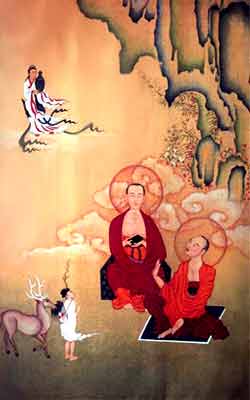 Teachings of Dignaga reveal that he presented a theory of immaterialism which is comparable to that advocated by Berkeley. He lived at a point when heated debates were going on among various Buddhist schools. He wrote books disapproving the views of his adversaries. As he was dissatisfied with a particular doctrine and he moved north to Magadha where he became a pupil of Vasubandhu.
Teachings of Dignaga reveal that he presented a theory of immaterialism which is comparable to that advocated by Berkeley. He lived at a point when heated debates were going on among various Buddhist schools. He wrote books disapproving the views of his adversaries. As he was dissatisfied with a particular doctrine and he moved north to Magadha where he became a pupil of Vasubandhu.
He advocated a certain metaphysical school of Buddhism. However later he moved away from it and became a disciple of Lord Buddha. Thereafter he became an analytical philosopher and logician. He advocated a system of logic which contains non-absolutism.
He annulled sensory perception and thoughts that involve concepts and inference. There is no conceptualisation in sensory perception. Perception cannot be described as they do not share similar features. He inherits the terms svalakshana and Samanya and lakshana from the Abhidharma. Svalak-sbana is an individual basic atomic factor. Non-eternity, unsatisfactoriness and lack of permanent identity are included in such generalities. He has considerably contributed to the theory of inference.
Features of Yogachara and Sautrantika theories of perception were combined with his logical methodology. He has defined perception in a new manner. He regarded According to him only pure sensation is perception. In his theory of inference theory he has differentiated between inference for oneself and inference for the other. He had introduced a new version of deductive reasoning.
His influential theory of cognition has been delineated in his main work, the Pramanasamuccaya. It is a theory that had a massive importance and has influenced in the development of Buddhist logic. The two basic elements in his theory are perception or pratyaksa and inference anumana.
He is the founder of the Buddhist school of epistemology and logic in India. He was a proponent of the Yogacara doctrine. However the notion of the alaya vijnana is not mentioned in any of his works. In some works he shows an interest in Sautrantika doctrine. Dignaga`s epistemological theories are expounded in the Pramanasamuccaya.
The originality of Dignaga lies in his insistence that an object of cognition must fulfil two necessary conditions: the object must be the cause of cognition, and it must possess the same form as that appears in the cognition. He examined and rejected the realist theories and concluded that the object of cognition is the form of an object that appears in the cognition. His major contribution in the field of logic is the invention of the "wheel of reasons". It shows nine possible relations between a logical reason and what is to be proven. It also enables one to distinguish a valid reason from an invalid reason.












